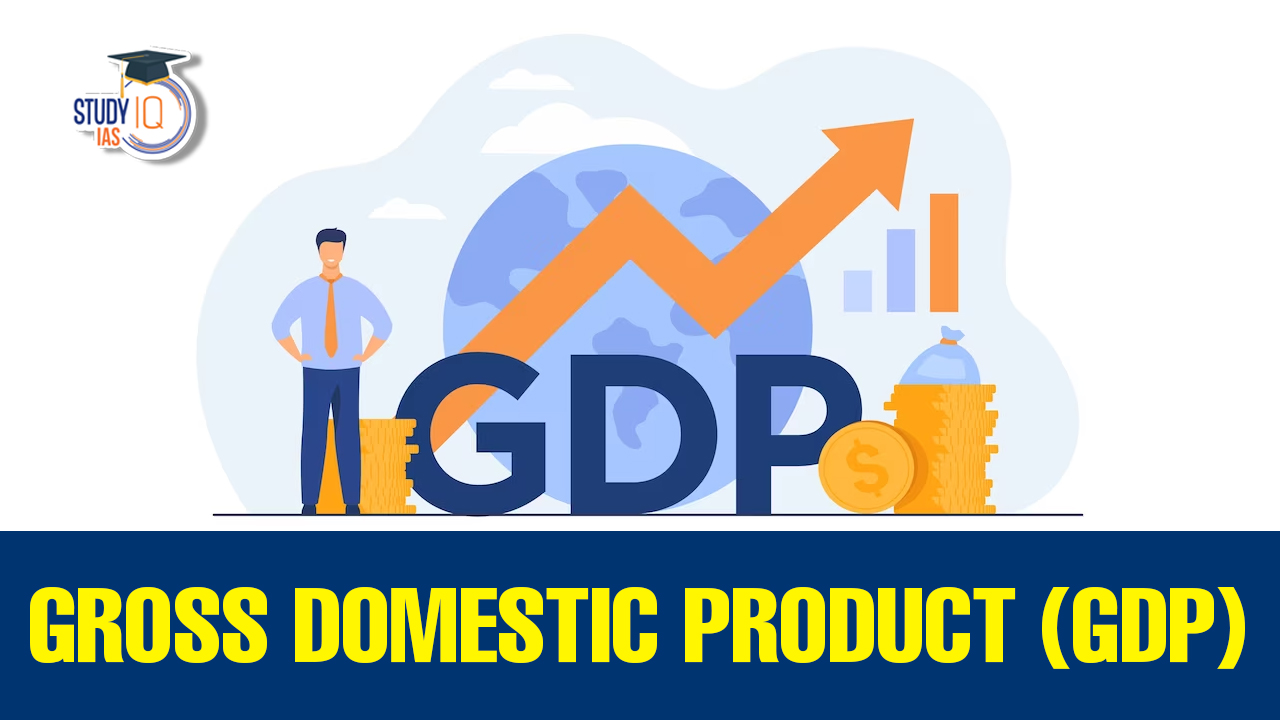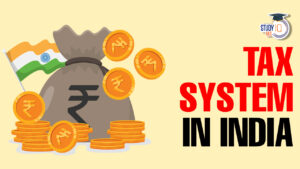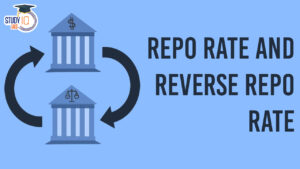Table of Contents
Gross Domestic Product is the Important topic for Indian Economy for the UPSC Civil Service Exam 2024. In this article we have discuss about the Importance, Types, Calculation, Real and Nominal GDP.
What is GDP?
GDP (Gross Domestic Product) stands as a cornerstone in assessing the economic health and performance of a nation. It serves as a vital indicator for policymakers, economists, and analysts, providing valuable insights into the size, growth, and productivity of an economy. In this article, we delve into the intricacies of GDP, exploring its significance, the factors it encompasses, and the role it plays in painting a comprehensive picture of a country’s economic landscape. By examining the key aspects and implications of GDP, we can grasp the fundamental concepts that underpin economic analysis and decision-making processes on a national scale.
Read about: Concept of GDP, GNP, NNP and NDP
Types of GDP
There are several different types of approaches to calculating GDP, each focusing on a specific aspect of economic activity. Here are some commonly recognized types of GDP:
| Types | Definition |
| Nominal GDP | Nominal GDP measures the value of goods and services produced at current prices without adjusting for Inflation. |
| Real GDP | Real GDP adjusts for inflation by measuring the value of goods and services produced using constant base-year prices. It provides a more accurate reflection of changes in production levels over time. |
| Gross Domestic Income (GDI) | GDI measures the total income generated by the production of goods and services within a country’s borders. It includes employee compensation, business profits, rental income, and net interest. |
| Gross National Product (GNP) | GNP measures the total value of goods and services produced by a country’s residents, both domestically and abroad. It includes income earned by residents from foreign sources and excludes income earned by foreigners within the country. |
| Purchasing Power Parity (PPP) GDP | PPP GDP adjusts GDP figures to account for differences in the cost of living between countries, allowing for more accurate international comparisons of economic output. |
| Per Capita GDP | Per Capita GDP is calculated by dividing the total GDP of a country by its population. It provides an average measure of economic output per person and is often used to compare living standards between countries. |
Read about: NRI Deposits
GDP Calculation
GDP (Gross Domestic Product) can be calculated using three main approaches, each focusing on a different aspect of economic activity. These approaches are known as the expenditure approach, income approach, and production (value-added) approach. Here’s a brief overview of each method:
Expenditure Approach
This approach calculates GDP by summing up the total expenditure on goods and services within a country during a specific time period. It accounts for four major components:
- Personal Consumption Expenditure (C): Spending by households on goods and services.
- Gross Private Domestic Investment (I): Investment in capital goods, residential structures, and business inventories.
- Government Consumption and Investment (G): Government expenditure on goods and services.
- Net Exports (X – M): The difference between exports (X) and imports (M).
GDP = C + I + G + (X – M)
Income Approach
This approach calculates GDP by summing up the total income generated in the economy during a specific time period. It accounts for various types of income, including wages, salaries, profits, rents, and interest.
GDP = Compensation of Employees + Rents + Interest + Profits + Taxes – Subsidies + Depreciation
Production (Value-Added) Approach
This approach calculates GDP by adding up the value-added at each stage of production within an economy. It focuses on the incremental value created by each producer in the production process and avoids double-counting.
GDP = Value Added by all Industries + Taxes – Subsidies
Read about: FERA and FEMA
GDP Calculation in India Since 2015
Changes in GDP Calculation Methodology in India since 2015 for National Income:
Change of Base Year
The base year for GDP calculation was changed from 2004-2005 to 2011-2012, following the recommendation of the National Statistical Commission. There is now consideration to change the base year again to 2017-18.
Replacement of Factor Cost with Market Prices
GDP is now measured using the gross value added (GVA) method at basic prices, rather than at factor cost. Industry-wise estimates are presented as GVA at basic prices, while GDP at market prices is referred to as GDP.
Alignment with International Practices
The new GDP methodology follows the international practice recommended by the United Nations System of National Accounts in 2008. This ensures the comparability of India’s GDP Growth numbers with those of developed nations in the future.
Broadening of Data Pool
The earlier data was based on the Annual Survey of Industries (ASI), which covered around two lakh factories. However, the new methodology incorporates data from the Ministry of Corporate Affairs (MCA21), including more than five lakh registered companies. This expanded data pool provides a more comprehensive view at the enterprise level, moving beyond the factory-level perspective.
Improved Coverage of Financial Corporations
The revised GDP calculation includes a wider range of financial corporations such as stock brokers, stock exchanges, asset management companies, mutual funds, pension funds, and regulatory bodies like SEBI, PFRDA, and IRDA. This enhanced coverage ensures a more accurate representation of the financial sector’s contribution to GDP.
Changes in Calculation of Agricultural Income
The calculation of agricultural income now includes not only value addition in farm produce but also value addition in livestock. For example, the value added to by-products of meat, such as the head, skin, and legs, is now included in the calculation. These changes in GDP calculation methodology aim to improve accuracy, align with international standards, capture a more comprehensive picture of economic activity, and reflect the evolving structure of the Indian Economy
.Read about: Capital Account Convertibility
Real and Nominal GDP
Here is a table that give a comparative analysis of these two concepts.
| Nominal GDP | Real GDP | |
| Definition | Value of goods and services produced using current market prices |
Value of goods and services produced using constant base-year prices adjusted for inflation
|
| Calculation | Does not adjust for inflation | Adjusted for inflation |
| Price Changes | Includes the impact of price changes |
Removes the impact of price changes
|
| Inflation Effects | Reflects both changes in output and changes in prices |
Reflects changes in output only
|
| Economic Performance | Can be influenced by changes in prices |
Provides a more accurate measure of economic growth
|
| Comparability | Not suitable for comparing GDP across different time periods |
Suitable for comparing GDP across different time periods
|
| Income Distribution | Does not consider changes in purchasing power |
Reflects changes in purchasing power
|
Read about: GDP of Indian States
Importance of GDP
The importance of GDP (Gross Domestic Product) can be summarized in the following points:
- Economic Indicator: GDP serves as a key economic indicator that reflects the size and growth of an economy, providing insights into its overall health and performance.
- Measure of Living Standards: GDP per capita is often used as an indicator of the average standard of living in a country, helping to assess the well-being and material progress of its citizens.
- Policy Tool: GDP data assists policymakers in formulating and evaluating economic policies, such as fiscal and monetary measures, to promote growth, stability, and development.
- International Comparisons: GDP enables comparisons between countries, allowing for assessments of relative economic strength, competitiveness, and potential investment opportunities.
- Investment Decision-Making: Investors, both domestic and foreign, rely on GDP data to assess market conditions, business potential, and overall economic stability before making investment decisions.
- Employment and Income Generation: GDP growth is often correlated with increased employment opportunities and income generation, contributing to poverty reduction and overall social welfare.
- Budget Planning: Governments use GDP estimates to plan budgets, allocate resources, and prioritize public expenditure on various sectors, such as healthcare, education, infrastructure, and social welfare programs.
- Business Performance Assessment: GDP data helps businesses evaluate the market size, demand trends, and consumer purchasing power, enabling them to make informed decisions regarding production, pricing, and expansion strategies.
- Economic Forecasting: GDP forecasts provide valuable insights into future economic trends, allowing businesses and individuals to anticipate market conditions and adjust their strategies accordingly.
- Data for Economic Research: GDP data serves as a valuable resource for economic research, analysis, and academic studies, contributing to a deeper understanding of economic phenomena and informing economic theories and models.
Read about: GDP Deflator
Gross Domestic Product (GDP) UPSC
- Understanding the concept of Gross Domestic Product (GDP) is crucial for UPSC aspirants as it is an important topic covered in the UPSC Syllabus 2024.
- GDP holds significance across various subjects like Economics, Indian Economy, and General Studies.
- Knowledge of GDP is essential for comprehending economic growth, and development, and measuring the overall performance of a country’s economy.
- Aspirants preparing for the UPSC exam can enhance their understanding of GDP through UPSC Online Coaching and by practising UPSC Mock Test, which often includes questions related to GDP and its impact on various aspects of the economy.
Read about: Capital Account Convertibility


 Tax System in India, Types, Tax Structur...
Tax System in India, Types, Tax Structur...
 Goods and Services Tax (GST), Objectives...
Goods and Services Tax (GST), Objectives...
 Repo Rate and Reverse Repo Rate, Impact ...
Repo Rate and Reverse Repo Rate, Impact ...




















